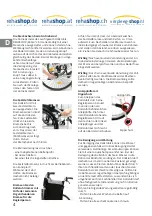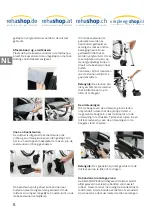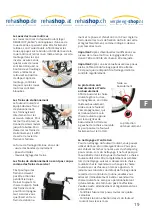
15
at
ch
A L L E S W E E R Z O G O E D A L S V R O E G E R
verpleeg-
nl
Warranty
We provide a warranty for this product in accor-
dance with European requirements, with the war-
ranty period covering the first twelve months. This
warranty is restricted to production and assembly
defects. We are not liable for wear and tear or for
any improper use or any abuse of the wheelchair.
The warranty will be voided in the event of any
modifications or repairs to the chair performed by
unauthorised retailers or any other unauthorised
person. It does not cover any costs incurred for
repairing defects, freight charges, loss of use or
loss of service, nor for any travel or similar costs.
Similarly, damage or injury arising from any impro-
per use, misuse, or failure to follow the instructions
are not covered by the warranty. The making of
any technical changes to the product is expressly
prohibited.
Technical data
Available seat widths: 41, 46 und 51 cm
Seat depth: approx. 41 cm
Wheelchair weight: approx. 14.5 kg
Rear wheels: 24” (approx. 61 cm) in diameter
Front wheels: 7” (approx. 18 cm) in diameter
Armrests: height adjustable
Footrests: removable and height adjustable
Seat upholstery: black and grey Nylon
Frame: Powder coated aluminium
Maximum load capacity: 110 kg
General safety instructions
Only use the wheelchair if it is free from defects.
Any inappropriate use of the wheelchair can cause
danger to the wheelchair user. For your own safety,
you must follow the rules set out below:
- Improperly performed adaptations or customisa-
tions increase the risk of accidents.
- As a wheelchair user, you are part of the general
road traffic and we therefore draw your attention
to the fact that, as a wheelchair user, you are
subject to the general road traffic laws.
- Wear the lightest clothing possible during the
hours of darkness.
- When using the wheelchair for the first time,
take particular care and get used to the effect of
changes in the centre of gravity on the handling of
the wheelchair.
- Practise using the wheelchair on flat ground, on
gradients and on slopes.
- The wheelchair’s holding brakes are not suitable
for stopping the wheelchair when in motion!
- The holding brakes are designed to prevent the
wheelchair from rolling away when stationary. If
you stop on an uneven surface, always use both
holding brakes. If the brakes are applied only on
one side, there is a risk that the wheelchair could
tip over.
- Use wheelchair ramps or lifts. If these are not
available, you should seek help to reach your des-
tination. The person assisting you should only
hold on to firmly attached parts of the wheelchair.
- The wheelchair must not be lifted with its occu-
pant; it must only be pushed if occupied.
- Check the quick release axles on the rear wheels,
the Velcro fasteners of the seat and the backrest,
the tyres, the tyre pressures if applicable, and the
brakes.
- The maximum permitted load of the wheelchair
is 110 kg.
- The wheelchair must be used exclusively to trans-
port people. No other use is permitted in line with
the stated purpose.
- When used on other forms of transportation,
such as trains or buses, the wheelchair user must
not sit in the wheelchair while travelling! Only se-
ats fitted in the relevant method of transport offer
adequate protection in the event of a dangerous
incident.
- If you make any changes to the configuration of
the wheelchair, it is important to read the relevant
Uneven surfaces can cause the wheelchair to
tip over, particularly when it is used on slopes or
gradients. If the wheelchair travels forwards up a
step or a gradient, the user’s body should be tilted
forwards.
- The wheelchair must only be used on firm
ground.
- The wheelchair is not designed to provide support
when standing up out of a squatting or sitting
position.
- The wheels of the chair may jam if they encoun-
ter an uneven surface, e.g., in gutters or gratings.
For this reason, you should avoid obstacles of this
nature wherever possible.
- Apply the wheelchair’s holding brake when par-
king the wheelchair to prevent any the wheelchair
from unintentionally rolling away.
- Always load the wheelchair vertically from above.
- On wet, dirty, icy, or sow-covered surfaces, there
is a significant risk of slipping! The effectiveness of
the brakes is also severely limited on these surfa-
ces! Adjust your usage style accordingly.
- Even when all detachable parts have been
removed, the wheelchair still weighs more than 10
kg. For this reason, the wheelchair should be lifted
GB








































